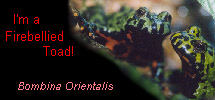
I'm not one for taking online quizzes. I could not resist, however, to try the What Kind of Frog Are You? survey on AllAboutFrogs.Org. I'm not sure how preferring butter to margarine equates with being a nocturnally hooting, toxin-secreting amphibian, but I'm still chuckling at my result: Oriental fire-bellied toad.
At my house we have five pets. One goldfish, named Pumpkin Pie, and four Bombina orientalis (i.e. Oriental fire-bellied toads). They're named Steinbeck, Stegner, Emily Dickinson, and Joan Didion.
These two-inch amphibians are excellent pets! They are incredibly easy to keep. We've had the toads for five years, leave them unattended while we're away, and haven't killed them yet. We feed them crickets twice a month; clean their tank when it looks nasty. They thrive. They coo sweet hooting sounds at night--okay, it's not so cute if you're sleeping near them.
Despite the designation "toad," these amphibians are mostly aquatic and need water. Fill the bottom of a tank with enough water to cover their bodies, but not so much that they can't keep their heads above it. Provide little "logs" that they can rest on and hide under. (They also like to hide in and around vegetation, real or fake.)
Just don't handle them unless you need to. Their bellies secrete a toxin that can irritate your skin, albeit a mild one. (Just wash your hands if you touch them.)
According to my froggy quiz:
These colorful toads are very active and fun for beginner pet owners. They enjoy spending their day swimming and singing with other frogs of their species and become more active when not alone. Weird fact: Firebellied toads cannot extend their tongues like other toads or frogs. To feed, they must leap forward and catch their prey with their mouths. After they have grabbed a cricket or worm with their mouth, they usually use their fore-arms to help stuff food the rest of the way in. Then they squish their eyeballs down in their heads to push the food into their throat.
Observing frogs seems to me to be an essential childhood experience. But it's getting harder to find them in the wild. Southern California's mountain yellow-legged frogs, red-legged frogs, and arroyo toads are endangered. Conservation biologists say nearly one-third of the world's amphibians are threatened with extinction. 129 may have gone extinct since 1980. Habitat loss, disease, pollution, predation by nonnative species, and UV radiation are among the culprits. A recent study by the International Union for Conservation of Nature (ICUN) concluded climate change could wipe out more than half of all amphibians.
One way to protect aquatic life is not to use pesticides in your yard. This tip sheet from the US Fish and Wildlife Service offers several ideas for keeping your garden environmentally sensitive.

Patricia,
ReplyDeleteThanks much for your kind comments. I'll check out your site.